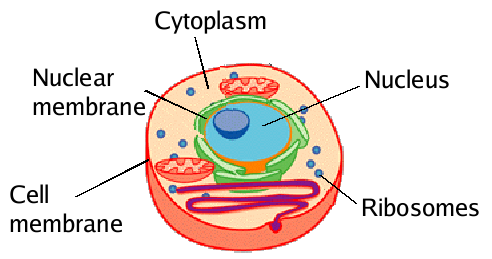
What is the smallest part of the body that is said to be alive?
Answer
490.8k+ views
Hint: Living organisms are made up of multiple components that work together to carry out the biological functions. Various organ systems are formed with the association of different organs that synchronize to perform a function. Similarly organs are formed by different tissues of same origin and function. Tissues are formed by the association of similar cells.
Complete answer:
The smallest part of any living organism’s body that is alive are the cells. It is the most basic structural and functional unit of any organism. Cells are the only component that can exist on its own. All the living organisms are composed of at least one cell, and all the new cells arise from this pre-existing cell. All the vital biological functions of the organisms take place within the cells. The information regarding the cell division is also stored within the cells. Thus cells function as the basic building blocks that aggregate to form a complete living organism. All the functions of the body are regulated at the cellular level. The cell is composed of three basic components, cell membrane, cytoplasm and the nucleus. There are differences in the structures of animal and plant cells.

Figure: Basic structure of a cell
Note:
There are two types of cells namely: prokaryotic and eukaryotic. Eukaryotic cells are well defined cells that have a well defined nucleus in it. These types of cells are found in all of the higher organisms and microscopic organisms such as fungi and protists such as amoeba. Prokaryotic cells are the primitive cells that are devoid of a well defined nucleus as well as other properly developed membrane bound organelles that are present in several bacteria.
Complete answer:
The smallest part of any living organism’s body that is alive are the cells. It is the most basic structural and functional unit of any organism. Cells are the only component that can exist on its own. All the living organisms are composed of at least one cell, and all the new cells arise from this pre-existing cell. All the vital biological functions of the organisms take place within the cells. The information regarding the cell division is also stored within the cells. Thus cells function as the basic building blocks that aggregate to form a complete living organism. All the functions of the body are regulated at the cellular level. The cell is composed of three basic components, cell membrane, cytoplasm and the nucleus. There are differences in the structures of animal and plant cells.

Figure: Basic structure of a cell
Note:
There are two types of cells namely: prokaryotic and eukaryotic. Eukaryotic cells are well defined cells that have a well defined nucleus in it. These types of cells are found in all of the higher organisms and microscopic organisms such as fungi and protists such as amoeba. Prokaryotic cells are the primitive cells that are devoid of a well defined nucleus as well as other properly developed membrane bound organelles that are present in several bacteria.
Recently Updated Pages
Why are manures considered better than fertilizers class 11 biology CBSE

Find the coordinates of the midpoint of the line segment class 11 maths CBSE

Distinguish between static friction limiting friction class 11 physics CBSE

The Chairman of the constituent Assembly was A Jawaharlal class 11 social science CBSE

The first National Commission on Labour NCL submitted class 11 social science CBSE

Number of all subshell of n + l 7 is A 4 B 5 C 6 D class 11 chemistry CBSE

Trending doubts
10 examples of friction in our daily life

One Metric ton is equal to kg A 10000 B 1000 C 100 class 11 physics CBSE

Difference Between Prokaryotic Cells and Eukaryotic Cells

1 Quintal is equal to a 110 kg b 10 kg c 100kg d 1000 class 11 physics CBSE

State the laws of reflection of light

Explain zero factorial class 11 maths CBSE




